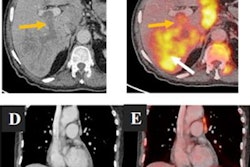
PET/CT imaging surpasses bone scintigraphy for detecting bone metastases in women with invasive breast cancer and should be the technique of choice to stage these patients, according to a team of investigators from Portugal.
Researchers at the University of Coimbra compared the approaches in a study that included 410 women treated at their cancer center between 2014 and 2020. They found that PET/CT was more accurate than bone scintigraphy, a result that could translate to better treatment approaches in these patients, wrote lead author and doctoral candidate Joana Santos and colleagues.
"Our study raises the question of whether bone scintigraphy is still necessary for bone cancer bone staging when PET/CT is available," the group wrote in a study published April 8 in the Oncologist.
Distant metastases are the main cause of death in women with breast cancer, with bone metastasis accounting for 20% of cases. Early detection of skeletal metastasis is essential for the management of the disease and to define staging and optimal treatments.
Hybrid metabolic imaging techniques such as PET/CT may have advantages for earlier detection of bone metastases in these patients, since standard bone scintigraphy does not typically identify lesions until bone marrow has been significantly damaged, the researchers explained. To complicate matters, no consensus exists on the most suitable imaging modality for this purpose, the group wrote.
To shed light on which approach may be best, the researchers analyzed scans from 410 women with invasive ductal carcinomas who had undergone both technetium-99m hydroxymethane diphosphonate (Tc-99m HDP) bone scintigraphy and F-18 FDG-PET/CT within two months. Distant metastases were identified in 112 (27.3%) patients, with bone metastasis seen in 81 (72.3%) of these patients.
Two senior nuclear medicine physicians categorized the cases as isolated metastasis (only one lesion), less than five bone lesions (between two and five), and more than five lesions based on both imaging techniques. The group then compared the accuracy, sensitivity, and specificity of the two imaging approaches.
PET/CT presented the highest accuracy and sensitivity values for most of the bone segments (upper limb, spine, sternum, pelvis, and sacrum). Bone scintigraphy performed better than PET/CT only for the cranium, the authors wrote.
| Bone metastases detection in breast cancer patients | |||
| Measure | Bone scintigraphy | PET/CT | p-value |
| Accuracy | 95% | 98% | 0.0775 |
| Sensitivity | 81% | 93% | 0.0442 |
| Specificity | 99% | 99% | 0.6831 |
"There is a significant difference in favor of PET/CT in bone metastases detection (sensitivity)," the group wrote. "However, there is no significant difference in eliminating false positives (specificity)."
The authors noted that, to their knowledge, this is the largest prospective study to address the question of whether bone scintigraphy is still necessary for breast cancer bone staging when PET/CT is available.
"PET/CT surpasses bone scintigraphy in the detection of breast cancer bone metastases and must be the technique of choice to stage these patients," they concluded.





















